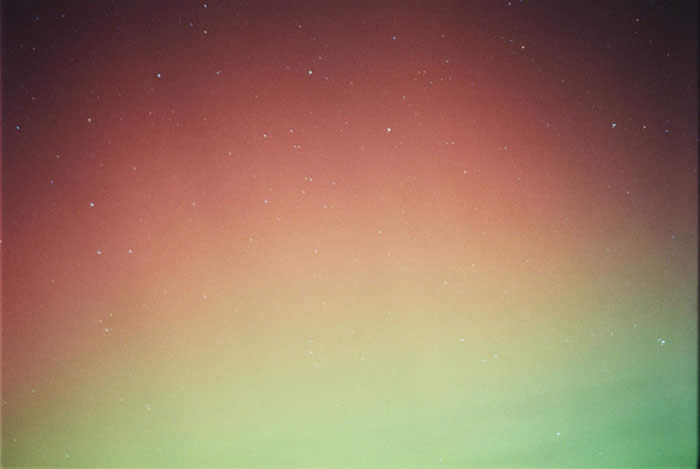Week 2 - Atmosphere: Origin, Composition, and Structure

The aurora results from radiation emitted as charged particles (ions) in the ionosphere return to neutral
or lower-energy states. Note the variety of colors in this particular aurora; in many auroras, only the color
green is predominant. (Photograph courtesy of Sandor Brasko's Astroimaging Gallery.)

Overview
During Week 2 you will learn the evolution of the atmosphere over the earth's history, its present-day composition and its vertical structure, in particular the average temperature profile. Phenomena of the upper atmosphere, such as the aurora (above) are briefly discussed. The basic differences between weather and climate are explained. You will learn the various types of models meteorologists use to study the atmosphere, and receive an introduction to the scientific method through discussion and examples. The history of surface and upper-air observing systems is presented. The two Laboratory Investigations involve interpretation of surface weather maps (2A) and plotting atmospheric temperature in the vertical (2B).
During Week 2 you will learn the evolution of the atmosphere over the earth's history, its present-day composition and its vertical structure, in
particular
Reading Assignment
Read Chapter 2, "Atmosphere: Origin, Composition, and Structure", in the Online Weather Studies text.
Investigation 2A - Surface Weather Maps
Directions for completing Investigation 2A:
1. Go to the Archives section of the American Meteorological Society website. The Archives link is located at the far left of the red bar near
the top of the pate. After clicking on the Archives link, click Fall 2007 on the next page, then on the following page select Week 2.
2. Under "Current Weather Studies", click on the Investigation A link and print out the associated file. Do the same for Image 1 (located immediately below Investigation A).
3. Go to Investigation 2A in the Online Weather Studies Investigations Manual. Complete items 1-15. You do not need to do items 16-32 (although you may for your own benefit), as these largely duplicate items from the AMS site. As for Laboratory Investigation 1, correct answers for the optional items (16-32) will be used to offset incorrect Current Weather Studies answers.
4. Answer questions 1-10 from the Investigation A file, referring to Image 1.
5. Submit your answers electronically using the Investigation A Answer Form link, found at the top right of the "Current Weather Studies" section. To use this form, either save it as a text (.txt) file or cut and paste the contents into a new Microsoft Word document. Next, edit your copy to select the correct answers. FInally, go to Lab 2 in the Assignments section of Moodle and paste your answers into the box, or attach them as a file.You may also send the send the file as an email attachment to the instructor at:
atuyl@sbcglobal.net or avantuyl@gavilan.edu.
Additionally, you can fax your answers to Gavilan at (408) 848-4873. Note that there are no figures to fax for Investigation 2A.
6. Deadline for Investigation 2A is midnight following Tuesday, March 6 (that is, midnight Wednesday morning).
Investigation 2B - The Atmosphere in the Vertical
Directions for completing Investigation 2B:
1. Go to the Archives section of the American Meteorological Society website, Week 2, as was done for Investigation 2A.
2. Under "Current Weather Studies", click on the Investigation B link and print out the associated file. Do the same for Image 1 (located immediately below Investigation B).
3.
Go to Investigation 2B in the Online Weather Studies Investigations Manual. Complete Items 1-10. Note that you are to draw on Figure 1 (page 2B-5). You do not need to do items 11-14 as these are similar to items from the AMS site (but again, you may do them if you find it helpful). Correct answers for optional items will once again be credited against incorrrect answers for Current Weather Studies.
4. Answer questions 1-5 from the Investigation B file, referring to Image 1. Item 1 asks you to draw on Image 1.
5. Fax page 2B-5 and Image 1 to Gavilan at (408) 848-4873. The multiple choice answers may either be faxed, or submitted electronically to Moodle as above (preferred). Answers may also be sent as email attachments to:
atuyl@sbcglobal.net or avantuyl@gavilan.edu.
6. Deadline for Investigation 2B is the same as for Investigation 2A.
Last updated
on
September 17, 2007

